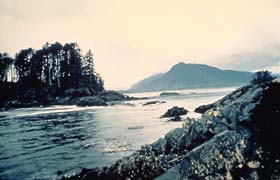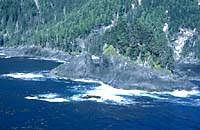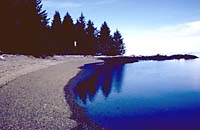(Page 1 of 2) |
During the end of the last ice age between 13,000 and 11,000 years ago, events resulted in very low water levels around Haida Gwaii. What is now Hecate Strait, the body of water that separates Haida Gwaii from the mainland, was for the most part dry land. Throughout this area of dry land, there were lakes and small rivers draining north and south to the Pacific Ocean. Soil samples from Hecate Strait indicate that many areas were habitable in the last ice age. After 10,000 years ago, the melting glaciers contributed to a rise in the sea level that resulted in a flooding of the Northwest Coast, temporarily creating beach lines high above today's high tide marks.

The memory of this drastic fluctuation of sea levels is preserved in the widespread flood myths of people along the Northwest Coast. Scores of these stories have been recorded. In 1892, James Deans, a Hudson's Bay Company trader, was told a legend that was very specific about glacial events at the Honna River on Haida Gwaii:
This is the story of the long long ago told amongst our people, the Hidery, that at Quilh-ca, about three miles west from the village of Illth-cah-geetla, or Skidegate's town, lived a boy whose name was Scannah-gan-nuncus . . .
. . . One day, making a further venture than usual, he sailed up the Hunnah, a mountain stream emptying its waters into Skidegate channel, four or five miles west from the place where he lived.
Tradition says that this river in those days was three times larger than it was nowadays. At present there is seldom water enough to float a canoe, unless at high water. It is also related that the waters of the sea stood higher on the land than is now the case. Of the rise of the land, evidence is everywhere to be seen; old landmarks show thirty feet.
After pulling up stream, he became tired; so, in order to rest, he pulled ashore and lay down. In those days at the place where he went ashore were large boulders in the bed of the stream, while on both sides of the river were many trees. While resting by the river, he heard a dreadful noise up stream, coming towards him. Looking to see what it was, he was surprised to behold all the stones in the river coming toward him. The movement of the stones frightened him so much that he jumped to his feet and ran into the timber. Here he found he had made a mistake, because all the trees were cracking and groaning; all seemed to say to him, "Go back, go back at once to the river, and run as fast as you can." This he lost no time doing. When again at the river, led by his curiosity, he went to see what was crushing the stones and breaking the trees. On reaching them, he found that a large body of ice was coming down, pushing everything before it. Seeing this, he got into his canoe and fled toward home.
Deans speculates, with some insight, on a problem that still puzzles us today:
Who was the author of this story, or when was it adopted by the Scannahs [Killer Whale phratry], I cannot say. Doubtless a tradition of ice coming down the Hunnah was current at the time when the Scannahs chose that fish as their crest. This event must have happened very early in the settlement of these islands, for tradition says at the time only two or three families lived on the southeast side of these islands, and that, excepting our hero and his grandmother, who lived at Quilh-cah, all the others dwelt in a small village on Maud Island, a mile and a half west from the others at Quilh-cah.
According to Haida tradition, there was a remnant of an earlier population on the west coast of Haida Gwaii. Marius Barbeau of the Canadian Museum of Civilization collected a flood legend from Henry Young of Skidegate in 1947. Intensive review of the body of flood and related myths of the Haida is likely to prove that they have inhabited Haida Gwaii since the end of the last ice age and thus constitute one of the oldest traceable populations of any in the New World.
The first traces of the Haida presence consist of roughly flaked stone tools found in intertidal areas that were once dry land. From earliest times, ocean-going canoes enabled these earliest inhabitants to communicate with neighbours to the north, from whom they adopted new forms of tools such as sharp stone flakes called microblades. These were preferably made of obsidian, a volcanic glass that can be precisely fingerprinted to identify its place of origin. The presence on the islands of obsidian from mainland sources long distances away provides a clue to the maritime skills of the ancient people of Haida Gwaii.
 
Archaeological surveys have located sites in all parts of Haida Gwaii that indicate the population was sizable by 5,000 years ago. At about that time, their economy was expanding from a primary reliance on hunting and fishing to include harvesting shellfish from the huge intertidal areas that surround many of the more protected waterways of the islands. The abundance of shellfish provided a virtually inexhaustible supply of food; it also made possible a stability of residence that allowed the establishment of more permanent villages where food, tools and other material objects could be safely stored, as well as the development of craftsmen who could devote more time to art. These changes led to the refinement of woodworking tools and skills, which, in turn, allowed for the construction of bigger and more elaborate canoes as well as larger plank houses.
Improved watercraft also meant that people were able to travel to food resources in far-flung areas and that warfare, particularly against mainland tribes, was a profitable venture. In fact, at the time of first contact with Europeans, the Haida could strike out from their island fortress and cross the treacherous waters of Hecate Strait, which they alone had mastered, with little fear of retribution from their mainland enemies.
|